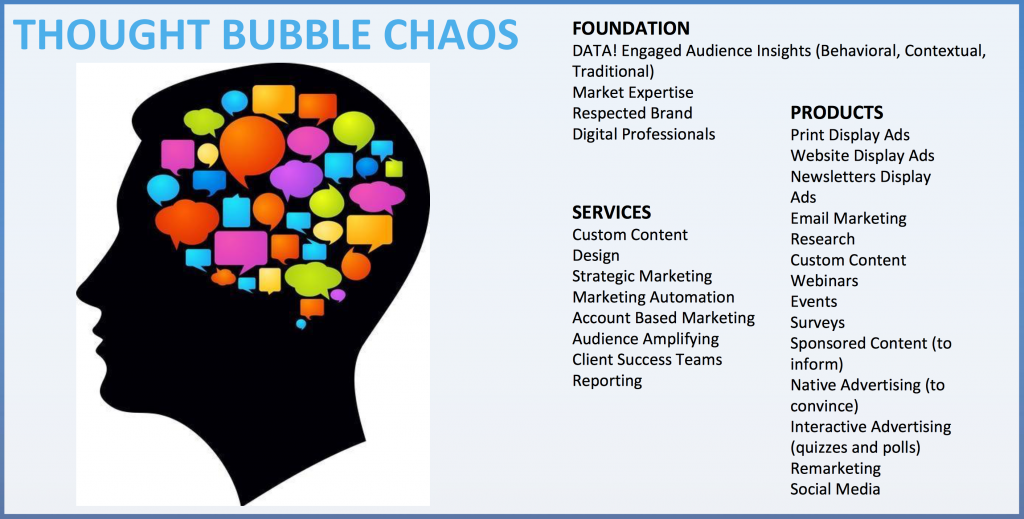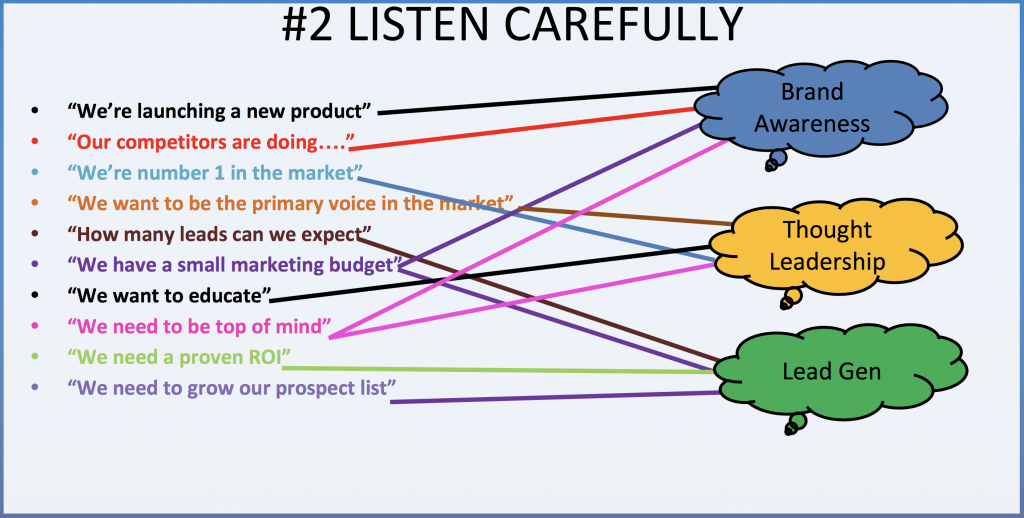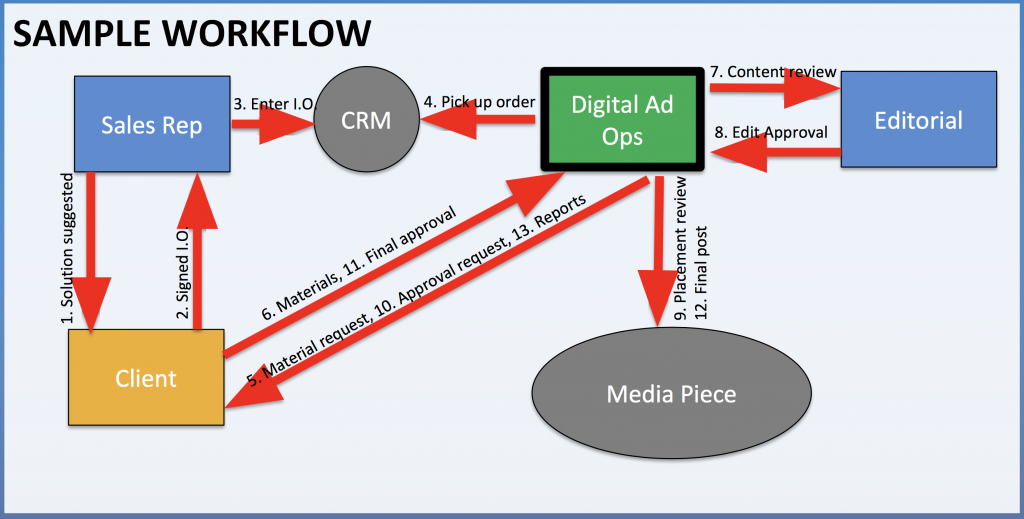How to Sell and Increase Revenue With Marketing Services
Last updated: May 20, 2024

Our very own CRO, James Capo, along with EnsembleIQ’s VP of Digital Media and Audience, Ronda Hughes, spoke at the Folio Show in New York last week. Their presentation on selling marketing products and services and increasing revenue through them was packed with helpful insights on maximizing the potential of your marketing services. The following write-up elaborates on the ideas from Ronda’s portion of the presentation.
Marketing can be an overwhelming, blanket term for tools and services your company provides. It can be difficult to understand where one ends and another begins. The range is vast, from traditional print special products to turnkey in-house “agency like” services such as persona identification to activation. If these products and services are not properly defined and understood, they won’t be best utilized. Examples of issues that can be encountered are not paying enough attention to the right audience and data, “services” starting to overshadow the right solution or product, not properly staffing to handle agency services, using custom ads with competitors, and clients of B2B media companies being agencies, who start to view you as a competitor.

Streamline your tech stack: Boost efficiency, unify data & retain talent! Get expert tips now
With the chaos that comes from the various products & offerings and factors of marketing services, organizing and classifying each individual tool and coming up with a selling process will help to best determine a baseline plan and capitalize on revenue. The four steps to doing so are: 1. to know and classify your products, 2. have a conversation (mostly with your ears), 3. sell/consult on solutions, and 4. sell/consult on services.
Know and Classify Your Products
Categorize your products into different buckets in order to understand 1. how each one works and 2. make it easier to identify when each should be used. The three buckets James and Rhonda gave were Brand Awareness, Lead Generation, and Thought Leadership. Brand Awareness encapsulates print and online advertising, remarketing and social media campaigns. Lead Generation covers email marketing, webinars, native advertising, infographics, blogs, events, sponsored content, surveys and quizzes. Tools that fall under Thought Leadership include Infographics, Webinars, Blogs, Sponsored Content, Research, and Polls. You can see that some of these products fall under more than one category because it is not easy to segment one solution from the next. However, having these general buckets is a great start to understanding the tools you can offer and what they will assist in for the business.
Have a Conversation – Listen Carefully
Once the products you offer are grouped into different purposes, the next step is to identify what your client is trying to solve with these products. Having a conversation and listening to the comments and problems that they are having is crucial to suggesting the proper strategy for forming a marketing plan. If they are saying things like “We’re launching a new product” or “Our competitors are doing…” then Brand Awareness should be the key focus. If the comments fall more within “We want to be the primary voice in the market” or “We want to educate,” Thought Leadership is the priority that needs to be filled. If the comments are “We need a proven ROI” or “We need to grow our prospect list,” then Lead Generation would be a great spot to focus. Sometimes comments may fall into more than one category of solutions, but use your best business sense, listen, and fully understand the tools you have to offer to come up with a plan that will best meet their needs.

Solution/Product Consultation
Consultative selling is the current way to approach a client that is interested in your business. The typical sales pitch that used to be the way to interact with clients is an outdated and inefficient way to approach a sale. Rather than coming across as a dishonest salesman, who only has his best interest at heart, look at this meeting as more of an opportunity to be a partner to your client, an ally for trying to solve their marketing needs. Before the meeting, it is important to know your own products and services, but also to know your client’s prospective audience and know your client’s possible budget. Ways to do so are by looking at last year’s budget and considering the size of the company.
Preparing for the meeting is only half the battle. While in the consultative meeting, there are certain points that are important to touch upon. Make sure to identify the desired outcome for your client – Brand Awareness, Lead Generation, or Thought Leadership. Also take into account the timing and longevity of potential campaigns as well as what your client would consider a successful campaign. Gauging expectations of the client will assist in assigning the proper tools and creating a good-fit marketing plan for them.
Services Consultation
The last part of the marketing sales journey is the services consultation. This is where the rest of the marketing package comes together. Along with the products you have to offer, also point out the services that makes you the perfect fit for your client. Some examples of special services include custom content and design, strategic marketing, marketing automation, account based marketing, audience amplifying, client success teams, and reporting.
During the consultation, the most efficient way to section all the marketing services and products is by either offering a full service (turnkey) option, or an a la carte option for both services and products. If the a la carte route is pursued, then pricing should start with baseline product pricing with upcharges for various add-on platforms, tools, and services. Every sales consultation will be different and should be catered to the individual client that is being worked with.
Once a deal has been made, a final way to truly maximize revenue from your marketing services is by assigning proper staffing for each account. As one size does not fit all, it is important to analyze each new account and determine the best number of people that should be staffed on it. There are certain tasks that one person could absorb all responsibility for, and there will be other tasks that must be delegated other members of the team. A sample workflow for a new client is below.

As you continue to sign new clients and implement this strategy, the process should get easier to execute. This simple process is a step in the right direction to fully maximizing revenue opportunities for marketing solutions. If you have any questions, please reach out to clientsuccess@omeda.com.
Subscribe to our newsletter
Sign up to get our latest articles sent directly to your inbox.